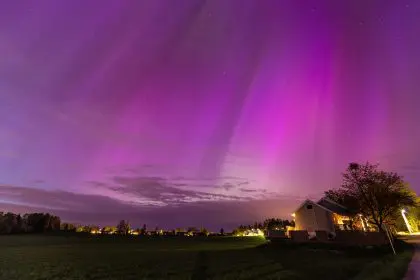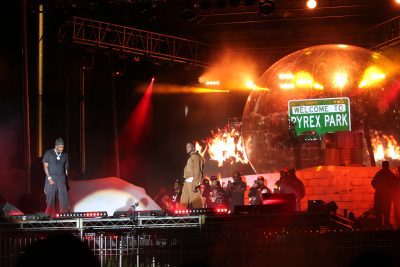Summer nights in Ohio are about to get more magical as the July full moon prepares to illuminate the sky with its captivating glow. This celestial event, known by the intriguing name “buck moon,” will reach its peak brilliance on Thursday, July 10, at 4:37 p.m. ET, offering stargazers across the Buckeye State an incredible opportunity to witness one of nature’s most spectacular displays.
The timing couldn’t be more perfect for Ohio residents eager to experience this lunar spectacle. With warm summer evenings providing ideal viewing conditions and clear skies expected across much of the state, this month’s full moon promises to be a memorable sight for astronomy enthusiasts and casual observers alike.
The fascinating origin of the buck moon name
The July full moon’s distinctive nickname stems from a remarkable connection to the natural world that many people find surprising. The term “buck moon” refers directly to male deer, whose antlers reach their full growth during this time of year, creating a beautiful synchronization between celestial and terrestrial cycles.
Male deer, known as bucks, undergo an annual antler growth cycle that perfectly aligns with the summer months. During July, these magnificent creatures display their antlers at or near their maximum size, having spent the spring and early summer developing these impressive natural crowns. The antlers, which are shed and regrown every year, become increasingly larger and more elaborate as the deer mature.
This natural phenomenon captivated early observers who noticed the correlation between the peak antler development and the July full moon. The connection seemed so significant that various cultures, particularly Native American tribes, incorporated this observation into their lunar naming traditions, giving us the enduring legacy of the buck moon designation.
Perfect viewing conditions across Ohio
Ohio’s geographic location and summer weather patterns create excellent conditions for moon viewing during July. The state’s relatively flat terrain in many areas provides unobstructed views of the horizon, while summer’s longer daylight hours mean the moon rises during comfortable evening temperatures when families can gather outdoors.
The July 10th full moon will be visible throughout the night, rising in the east as the sun sets and traveling across the sky until dawn. Ohio residents can expect the moon to appear larger and more colorful when it’s closer to the horizon, particularly during moonrise and moonset, due to atmospheric effects that enhance its visual impact.
Urban areas like Columbus, Cleveland, and Cincinnati will still offer good viewing opportunities, though rural locations away from city lights will provide the most spectacular experience. Parks, lakeshores, and open fields throughout Ohio will serve as perfect viewing locations for this celestial event.
Current lunar phase progression
As of July 7th, the moon is currently in its waxing gibbous phase at 90% illumination, steadily building toward its full phase in just a few days. This progression creates an exciting buildup to the main event, allowing observers to watch the moon grow brighter and more complete each night.
The complete July lunar cycle unfolds as follows:
- First quarter occurred on July 2nd, marking the halfway point between new moon and full moon
- Full moon peaks on July 10th at 4:37 p.m. ET
- Last quarter follows on July 17th, beginning the waning phase
- New moon completes the cycle on July 24th
This predictable pattern allows astronomy enthusiasts to plan their viewing schedules and understand the moon’s current position in its monthly journey around Earth.
What makes this buck moon special
While every full moon offers its own unique beauty, July’s buck moon holds particular significance for several reasons. The summer timing means longer periods of darkness for extended viewing, while the moon’s position in the sky during July often creates especially dramatic visual effects.
The buck moon also represents the peak of summer’s natural abundance, occurring when wildlife is most active and nature displays its full vitality. This timing made the July full moon especially important to agricultural societies, who used lunar cycles to guide planting, harvesting, and other seasonal activities.
Ohio’s diverse wildlife population means that residents might actually spot deer during buck moon viewing sessions, particularly in suburban areas where these animals have adapted to human presence. The connection between the moon’s name and local wildlife creates an enhanced viewing experience that combines astronomy with nature observation.
Optimal viewing strategies for Ohio residents
To make the most of the buck moon viewing experience, Ohio residents should consider several factors that can enhance their observation. The moon will be most impressive during the first few hours after sunset, when it appears largest and most colorful due to atmospheric effects.
Finding a location with an unobstructed eastern horizon provides the best moonrise viewing opportunity. Ohio’s numerous state parks, lakeshores, and rural areas offer excellent vantage points away from light pollution that can diminish the moon’s impact.
Weather conditions play a crucial role in viewing success. Clear skies obviously provide the best experience, but even partially cloudy conditions can create dramatic effects as the moon appears and disappears behind cloud formations. Ohio’s summer weather patterns generally favor clear evening skies, making July an ideal month for lunar observation.
Photography opportunities during the buck moon
The buck moon presents excellent photography opportunities for both amateur and experienced photographers. The moon’s brightness and size make it an ideal subject for various photographic techniques, from simple smartphone captures to elaborate telescope photography.
Early evening hours, when the moon appears larger near the horizon, provide the most dramatic photographic opportunities. The warm colors created by atmospheric filtering during this time create stunning images that capture the moon’s natural beauty against Ohio’s landscape.
Combining lunar photography with foreground elements like trees, buildings, or bodies of water creates compelling compositions that tell a story about the connection between celestial events and earthly settings. Ohio‘s diverse landscapes provide numerous opportunities for creative moon photography.
Connection to upcoming celestial events
The buck moon serves as just one highlight in a summer filled with astronomical wonders. Following this lunar spectacle, Ohio residents can look forward to additional celestial events throughout the summer months, including meteor showers, planetary alignments, and the approaching nova explosion that astronomers predict will be visible to the naked eye.
August’s full moon, known as the sturgeon moon, will peak on August 9th, providing another opportunity for lunar observation. This continuation of monthly full moons creates a rhythm of celestial events that can become a regular part of summer evening activities.
The remaining months of 2025 will feature six more full moons, with three qualifying as supermoons when the moon appears larger and brighter due to its closer proximity to Earth. These future events build anticipation for continued astronomical observation throughout the year.
Cultural and historical significance
The buck moon designation reflects humanity’s long-standing practice of connecting celestial events with natural phenomena. This naming tradition demonstrates how our ancestors observed and understood the intricate relationships between lunar cycles and wildlife behavior.
Different cultures have developed their own names for July’s full moon, reflecting local wildlife and seasonal changes. Some alternative names include the thunder moon, hay moon, and elk moon, each highlighting different aspects of July’s natural characteristics.
These traditional names serve as reminders of humanity’s deep connection to natural cycles and the importance of celestial observation in pre-industrial societies. Modern moon viewing continues this ancient tradition while incorporating contemporary understanding of astronomy and lunar mechanics.
Making the most of the buck moon experience
Ohio families can turn buck moon viewing into a memorable shared experience by combining observation with education about astronomy, wildlife, and natural cycles. The July timing makes outdoor activities comfortable and enjoyable for all ages.
Creating a moon viewing ritual can enhance the experience, whether through simple observation, photography, or incorporating related activities like reading about lunar phases, discussing wildlife behavior, or planning future astronomical events.
The buck moon offers a perfect introduction to astronomy for children and adults who might be curious about celestial events but haven’t yet developed regular observation habits. The dramatic visual impact of a full moon creates immediate interest that can spark long-term enthusiasm for astronomy.
Preparing for the viewing experience
Successful buck moon viewing requires minimal preparation but benefits from some advance planning. Checking weather forecasts helps identify the best viewing nights, while scouting locations during daylight hours ensures optimal positioning for the evening event.
Basic equipment like binoculars can enhance the viewing experience by revealing lunar surface details, though the buck moon’s beauty is fully accessible to naked-eye observation. Comfortable seating, warm clothing for later evening viewing, and perhaps some snacks can make the experience more enjoyable for extended observation sessions.
Ohio’s buck moon viewing promises to be a highlight of the summer’s astronomical calendar, offering residents an opportunity to connect with natural cycles, enjoy family time outdoors, and appreciate the ongoing celestial dance that has captivated humanity throughout history.













